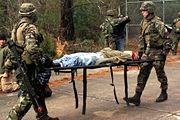Stretcher

A stretcher is a medical device used to carry casualties or an incapacitated person from one place to another. It is a simple type of litter, and still called by that name in some cases.
A stretcher is usually carried by two people, one at the head and the other at the feet. The casualty is placed on the stretcher, and can then be carried away. This usually occurs if the person is unable to walk by themselves, or if other requirements mean a "stair chair" (wheelchair), or similar could not be used. Many times the casualty is strapped down to avoid further injury.
Contents |
History
Stretchers have been used since antiquity, especially on battlefields and in emergency situations, where wheeled vehicled are hindered by rough terrain. In their simplest form, they generally consisted of a canvas sling with long edges sewn to themselves to form pockets through with wooden poles could be slid. This form was common with militaries right through the middle of the 20th century.
Modern stretchers

The stretchers used in ambulances have wheels that makes transportation over pavement easier, and have a lock inside the ambulance to secure the victim during transport.
"Normalised" stretchers, or folding stretchers, are the simplest type. They are made of two poles and two transversal hinged bars with a cloth stretched between the poles and four feet. The bars can be folded for storage. They are now rarely used by modern emergency services, but are still widely used by organisations for whom the storage space is an important factor, e.g. first aid associations, or French companies (a stretcher is mandatory). These stretchers are often used as beds.
Disaster stretchers are designed for easy storage and transport. They consist of a tubular aluminum structure with a washable cloth. They cannot be folded, but can be piled up.
As normalised or disaster stretcher have no wheel, they are usually carried by three or four people. When they must be carried by only two people, they tie straps to the poles, so the weight is supported by the shoulders and not by the hands.
Lifting and carrying devices
The casualty must be lifted (scoop) to be put on the stretcher. This lifting can be made manually, but it is also possible to use specific devices. These devices can be also used as stretchers, but only for short distances.
A long spine board can be used to scoop and carry the patient to the stretcher; in case a spine trauma is suspected, the victim is left on the board and tied to it and the board is simply put on the stretcher. The spine and the overall immobilisation can also be performed by a vacuum mattress put on the stretcher.
A padded spineboard is similar to a long spine board, but has padding on top of the plastic surface to keep emergency victims more comfortable while they are strapped to the backboard.
When there is no suspicion of spine trauma, the vacuum mattress can be used as a stretcher (it has handles), which is best in narrow places when the stretcher cannot be kept horizontal. It is more secure and comfortable than strapping the patient to the stretcher.

The scoop stretcher is used for lifting patients, for instance from the ground onto an ambulance stretcher trolley or long board. The two ends of the stretcher can be detached from each other, splitting the stretcher into two longitudinal halves. To load a patient, one or both ends of the stretcher are detached, the halves placed under the patient from either side and fastened back together. With obese patients, the possibility exists of accidentally pinching the patient's back when closing the stretcher, so care must be made not to injure them when carrying out this procedure.
A reeves stretcher, or 'flexible stretcher', is a flexible stretcher that is supported longitudinally by wooden or plastic planks. It is a kind of tarpaulin with handles. It is primarily used to move a patient through confined spaces (e.g. a narrow hallway), or to lift obese patients (reeves stretchers have 6 handholds, allowing multiple rescuers to assist extrication). Law enforcement officers sometimes use the Reeves stretcher as a humane method of restraint.
To load the patient, the stretcher is folded, and the patient is rolled aside so the stretcher can be slid under him/her. The stretcher is then unfolded. For the patient's comfort, a dry sheet is often folded into the stretcher.
Other types of stretchers
- The Nimier stretcher (brancard Nimier) : this stretcher was used by the French army during World War I. The casualty was placed on his back, but in a "seated position", (that is, the thighs were perpendicular to the abdomen). Thus, the stretcher was shorter and could turn in the trenches (see a picture).
- Hypothermia stretchers have insulation or heating elements to reduce the risk of hypothermia while in transit.
Most regular Spine boards do not have the "scoop function" as they are built in one piece. Some scoop stretchers may have the ability to function as the Spine board and Vacuum mattress and give a total spinal immobilization if they are built for that purpose and include spine board straps an a head immobilizer. The use of spine boards and vacuum mattresses must also include the use of a cervical immobilisation collar to provide a total spinal immobilization.
See also
- gateleg table
- gurney
- casualty movement
- litter (rescue basket)